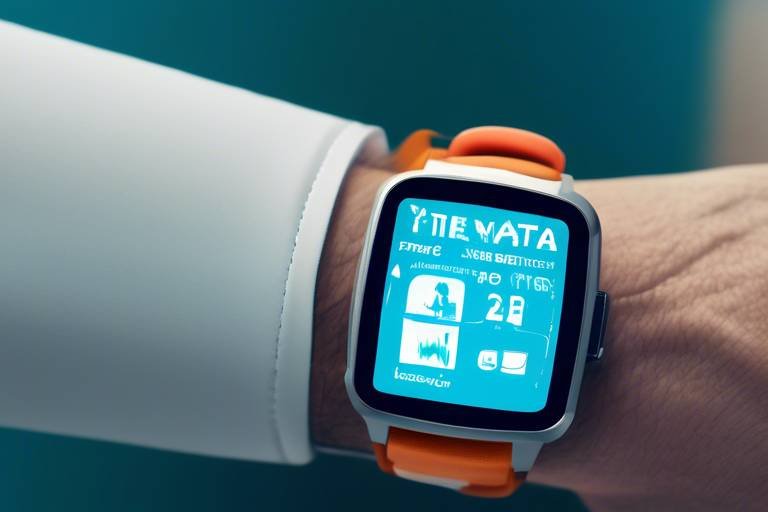How Virtual Reality is Enhancing Scientific Research
In recent years, virtual reality (VR) has emerged as a groundbreaking tool in the realm of scientific research, revolutionizing the way scientists approach their work. Imagine stepping into a world where you can manipulate molecules, explore distant planets, or even visualize complex data sets in three dimensions. This is not just a dream; it's the reality that VR technology brings to researchers across various fields. By immersing themselves in virtual environments, scientists can gain insights that were previously unimaginable, enhancing their understanding and experimentation capabilities. As we delve deeper into this topic, we'll explore how VR is being applied in different scientific disciplines, the benefits it offers to researchers, and the challenges that come with its implementation.
Virtual reality is being utilized in diverse scientific disciplines, from biology to physics, providing immersive experiences that enhance understanding and experimentation. For instance, in biological research, VR allows scientists to visualize cellular structures and interactions at a microscopic level. This immersive experience can lead to breakthroughs in understanding diseases and developing treatments. In the field of physics, researchers can simulate experiments that are either too dangerous or impractical to conduct in the real world, such as particle collisions or astrophysical phenomena. The applications are vast and varied, making VR a versatile tool in the scientific toolkit.
Researchers benefit from VR through improved data visualization, enhanced collaboration, and the ability to simulate complex scenarios that would be difficult or impossible to replicate in real life. One of the most significant advantages is the improved data visualization that VR offers. Traditional methods of data analysis often rely on two-dimensional representations, which can obscure important patterns and insights. With VR, researchers can visualize complex datasets in three dimensions, making it easier to identify trends and relationships that might otherwise go unnoticed.
VR allows researchers to visualize complex datasets in three dimensions, making it easier to identify patterns and insights that traditional methods may overlook. Imagine being able to walk through a data set, examining it from different angles and perspectives. This level of interaction fosters a deeper understanding of the data and can lead to innovative solutions. For example, in climate science, researchers can use VR to visualize climate models, allowing them to better understand the potential impacts of climate change on various ecosystems.
Through interactive VR environments, researchers can manipulate and explore data in real-time, leading to deeper insights and innovative solutions. This hands-on approach not only makes data analysis more engaging but also allows for a more intuitive understanding of complex information. As researchers interact with their data, they can test hypotheses and explore "what-if" scenarios, which can lead to new discoveries and advancements in their respective fields.
VR enables researchers to receive immediate feedback on their hypotheses and experiments, facilitating a more dynamic and responsive research process. This real-time analysis is crucial in fast-paced research environments where time is of the essence. By allowing scientists to test and refine their ideas on the fly, VR can accelerate the pace of discovery and innovation.
Virtual reality fosters collaboration among researchers worldwide, enabling them to share findings, brainstorm, and conduct experiments together in a shared virtual space. This is particularly valuable in today's globalized research environment, where teams are often spread across different continents. With VR, scientists can meet in a virtual lab, share their screens, and work together on projects as if they were in the same room. This capability not only enhances teamwork but also promotes the exchange of ideas and knowledge across borders.
Despite its benefits, integrating VR into scientific research poses challenges, including high costs, technical limitations, and the need for specialized training. The initial investment required for VR technology can be prohibitive for some research institutions, limiting access to this innovative tool. Moreover, researchers may face technical challenges when using VR, necessitating comprehensive training to ensure effective implementation and maximize the technology's potential.
The initial investment required for VR technology can be prohibitive for some research institutions, limiting access to this innovative tool. The cost of high-quality VR equipment, software licenses, and ongoing maintenance can add up quickly. This creates a disparity in access to VR technology, where only well-funded institutions can fully leverage its potential.
Researchers may face technical challenges when using VR, necessitating comprehensive training to ensure effective implementation and maximize the technology's potential. Learning to navigate VR environments and utilize the software effectively can be daunting for those unfamiliar with the technology. As a result, institutions need to invest in training programs to help researchers adapt to this new tool.
The future of VR in scientific research looks promising, with advancements in technology and increasing adoption likely to drive new applications and methodologies. As VR technology continues to evolve, researchers can expect improved hardware and software that enhance user experience and expand research capabilities. Furthermore, the integration of VR with artificial intelligence and machine learning could revolutionize scientific research, offering new ways to analyze data and simulate experiments.
As VR technology continues to evolve, researchers can expect improved hardware and software that enhance user experience and expand research capabilities. These advancements could lead to more realistic simulations, better graphics, and more intuitive interfaces, making VR an even more powerful tool for researchers.
Combining VR with artificial intelligence and machine learning could revolutionize scientific research, offering new ways to analyze data and simulate experiments. This integration could lead to breakthroughs in fields like drug discovery, where AI can analyze vast amounts of data while VR provides an immersive environment for visualization and interaction.
- What is virtual reality? Virtual reality is a simulated experience that can be similar to or completely different from the real world, often involving interactive 3D environments.
- How is VR used in scientific research? VR is used in various fields to visualize complex data, simulate experiments, and enhance collaboration among researchers.
- What are the benefits of using VR in research? Benefits include improved data visualization, enhanced collaboration, and the ability to simulate complex scenarios.
- What challenges does VR face in research? Challenges include high costs, technical limitations, and the need for specialized training.

Applications of VR in Scientific Research
Virtual reality (VR) is not just a fad; it's a powerful tool that's reshaping the landscape of scientific research across various disciplines. Imagine stepping into a virtual lab where you can manipulate molecular structures in 3D or explore the depths of the ocean without getting wet. This is the reality that VR brings to researchers, allowing them to experience and interact with data in ways that traditional methods simply can't match.
In the field of biology, for instance, VR is used to simulate ecosystems, allowing researchers to observe interactions within a habitat without disturbing it. This immersive experience can lead to significant breakthroughs in understanding species behavior and environmental impacts. Additionally, in medical research, VR is being employed for surgical training. Medical students can practice procedures in a risk-free environment, honing their skills before they ever step into an operating room.
Physics is another domain where VR shines. Researchers can visualize complex physical phenomena, such as particle collisions or gravitational waves, in a virtual space. This not only aids in conceptual understanding but also helps in teaching these intricate concepts to students who might struggle with traditional learning methods. The ability to see and manipulate these phenomena in real-time can spark curiosity and enhance learning outcomes.
Moreover, VR is making waves in psychology and social sciences. Researchers can create controlled environments to study human behavior, test theories, and simulate social interactions. For example, by immersing participants in a virtual environment, psychologists can observe how individuals react to various stimuli, leading to insights that could be invaluable for understanding mental health disorders.
To illustrate the diverse applications of VR in scientific research, consider the following table:
| Field | Application | Benefits |
|---|---|---|
| Biology | Simulating ecosystems | Understanding species behavior without disruption |
| Medical Research | Surgical training | Risk-free practice for medical students |
| Physics | Visualizing physical phenomena | Enhanced conceptual understanding and teaching |
| Psychology | Studying human behavior | Controlled environments for observing reactions |
As we can see, the applications of VR in scientific research are vast and varied. Each field benefits from its unique capabilities, paving the way for innovative approaches to complex problems. The immersive nature of VR not only enhances the research experience but also democratizes access to advanced research tools, allowing more people to engage with science in meaningful ways. So, the next time you think about virtual reality, remember that it's not just about gaming or entertainment; it's a revolutionary force in the world of scientific inquiry.

Benefits of Using VR for Researchers
In the rapidly evolving landscape of scientific research, virtual reality (VR) is emerging as a game-changer, offering a plethora of benefits that enhance the research process. One of the most significant advantages is improved data visualization. Traditional methods of data representation often fall short when it comes to conveying complex information. With VR, researchers can immerse themselves in a three-dimensional space where data comes to life. Imagine exploring a dataset not just on a flat screen, but as a dynamic environment where you can walk through and interact with the data. This immersive experience leads to a better understanding of intricate relationships and patterns that might otherwise remain hidden.
Furthermore, VR enhances interaction with data in ways that were previously unimaginable. Instead of merely observing data, researchers can manipulate and explore it in real-time. This hands-on approach fosters a deeper connection to the material, allowing for innovative insights and solutions to emerge. Picture a biologist examining cellular structures or a physicist visualizing particle collisions; the ability to interact with their data creates a more engaging and productive research experience.
Another remarkable benefit of VR is the provision of real-time feedback and analysis. In traditional research settings, feedback loops can be slow and cumbersome. However, with VR, researchers can test hypotheses and receive immediate responses to their experiments. This rapid feedback mechanism not only accelerates the research process but also encourages a more dynamic and responsive approach to scientific inquiry. It’s akin to having a conversation with your data rather than simply observing it from a distance.
Collaboration is also significantly enhanced through VR. Researchers from different corners of the globe can come together in a shared virtual space, breaking down geographical barriers. This fosters a collaborative environment where ideas can flow freely, and innovative solutions can be brainstormed collectively. Imagine a team of scientists working on a project about climate change, where they can visualize data from various locations and share insights in real-time, all while feeling as though they are in the same room. This level of collaboration not only boosts productivity but also enriches the research with diverse perspectives.
However, it’s essential to address that while the benefits are substantial, the implementation of VR technology in research requires careful consideration. Researchers must weigh the advantages against potential challenges such as cost and technical limitations. Yet, the potential for improved outcomes makes VR an exciting avenue for the future of scientific exploration.
- What fields of research can benefit from VR?
VR can be applied in various fields including biology, chemistry, physics, and social sciences, enhancing visualization and interaction with complex data. - Is VR technology expensive to implement?
Yes, the initial costs can be high, but many institutions are finding ways to integrate VR through grants and partnerships. - Do researchers need special training to use VR?
Yes, comprehensive training is often necessary to ensure researchers can effectively utilize VR technology and maximize its potential.

Improved Data Visualization
One of the most exciting aspects of virtual reality (VR) in scientific research is its ability to provide . Imagine diving into a three-dimensional world where complex datasets transform into interactive visual representations. This immersive experience allows researchers to see their data in ways that traditional two-dimensional graphs and charts simply cannot convey. Instead of staring at a flat screen filled with numbers and lines, scientists can literally walk around their data, exploring it from different angles and perspectives.
For instance, in fields like biology and environmental science, researchers can visualize intricate models of ecosystems or cellular structures. By stepping into a virtual environment, they can interact with these models, zooming in on specific areas, and manipulating variables to see how changes affect the entire system. This hands-on approach not only enhances understanding but also sparks creativity, leading to innovative solutions and hypotheses.
Moreover, VR facilitates the visualization of multidimensional data that would otherwise be challenging to interpret. With the ability to represent data in three or even four dimensions, researchers can uncover hidden patterns and correlations that might go unnoticed in traditional formats. For example, consider a study examining the effects of climate change on various species. By using VR, scientists can overlay temperature changes, migration patterns, and population dynamics in a cohesive virtual space, allowing for a comprehensive analysis that is both intuitive and enlightening.
In addition to enhancing understanding, VR also provides real-time interactivity. Researchers can manipulate data points, adjust parameters, and instantly see the effects of their changes. This dynamic interaction fosters a deeper engagement with the research material and promotes a more exploratory mindset. It’s akin to being a pilot in a flight simulator—where every adjustment in the controls leads to immediate feedback, allowing for rapid learning and adaptation.
Furthermore, the use of VR in data visualization can significantly enhance collaboration among researchers. By creating a shared virtual space, teams from different geographical locations can come together to explore data collectively. Imagine a group of scientists from around the world, each contributing their expertise, as they navigate a virtual model of a complex phenomenon. This collaborative approach not only enriches the research but also builds a community of knowledge sharing and innovation.
In conclusion, the integration of virtual reality in scientific research is revolutionizing the way researchers visualize and interact with data. It opens up new avenues for exploration, encourages collaboration, and enhances understanding in ways that were previously unimaginable. As VR technology continues to evolve, we can expect even more groundbreaking applications that will further elevate the standards of scientific inquiry.
- What is virtual reality? Virtual reality is a simulated experience that can be similar to or completely different from the real world, often using special equipment like headsets to immerse users.
- How does VR improve data visualization? VR allows researchers to visualize complex datasets in three dimensions, enabling them to interact with and manipulate data in real-time for deeper insights.
- What are the benefits of using VR in research? Benefits include enhanced data visualization, improved collaboration, and the ability to simulate scenarios that are difficult to replicate in real life.
- What challenges does VR face in scientific research? Challenges include high costs, technical limitations, and the need for specialized training to effectively use the technology.

Enhanced Interaction with Data
Imagine stepping into a world where data isn't just numbers on a screen but a vibrant landscape you can explore. That's the magic of virtual reality (VR) in scientific research. With VR, researchers can interact with their data in ways that were once thought to be the stuff of science fiction. Instead of merely observing data trends from a distance, scientists can now walk through complex datasets, manipulate variables, and even visualize outcomes in real-time. This immersive interaction allows for a deeper understanding of the data, much like how a sculptor feels the contours of their work as they shape it with their hands.
One of the standout features of VR is its ability to transform abstract data into tangible experiences. For instance, researchers studying climate change can visualize atmospheric data as a three-dimensional globe, allowing them to see the impact of temperature changes across different regions. This kind of visualization not only makes the data more accessible but also sparks curiosity and engagement among researchers and audiences alike. The experience is akin to being a pilot flying over a landscape, where you can see the changes from above and understand the broader context.
Furthermore, VR's interactive capabilities enable researchers to conduct simulations that mimic real-world scenarios. By manipulating variables within a virtual environment, scientists can observe how changes affect outcomes instantly. This process is particularly beneficial in fields like biology and engineering, where understanding the relationship between different factors is crucial. For example, a biologist could simulate the effects of a new drug on cellular structures, adjusting dosages and observing reactions in a controlled virtual space. This not only saves time and resources but also enhances the accuracy of the research.
Another significant advantage of enhanced interaction with data through VR is the potential for collaborative exploration. Researchers from different parts of the world can enter the same virtual environment, share their findings, and manipulate data together. This collaborative aspect fosters innovation and creativity, as diverse perspectives can lead to unexpected insights. Picture a team of scientists discussing their findings while simultaneously interacting with a 3D model of their research—it's a game-changer in how scientific collaboration is approached.
In conclusion, enhanced interaction with data through virtual reality is revolutionizing the way researchers approach their work. It transforms abstract concepts into immersive experiences, allowing for deeper insights and collaborative efforts that were previously unimaginable. As VR technology continues to advance, the possibilities for enhanced data interaction will only expand, making scientific research more engaging and impactful than ever before.
- What is virtual reality in scientific research?
Virtual reality in scientific research refers to the use of immersive technology to visualize and interact with data in a three-dimensional space, allowing researchers to gain deeper insights and conduct experiments in a virtual environment.
- How does VR improve data visualization?
VR enhances data visualization by allowing researchers to explore complex datasets interactively, making it easier to identify patterns and relationships that might be missed using traditional methods.
- What are the benefits of using VR for collaboration?
VR fosters collaboration by enabling researchers from different locations to share a virtual space, discuss findings, and experiment together in real-time, leading to innovative solutions and shared knowledge.
- Are there any challenges to implementing VR in research?
Yes, challenges include high costs of technology, technical limitations, and the need for specialized training to effectively use VR tools in research.

Real-Time Feedback and Analysis
In the fast-paced world of scientific research, having the ability to receive real-time feedback can make all the difference. Imagine conducting an experiment where you can instantly see the results and adjust your approach on the fly. This is precisely what virtual reality (VR) brings to the table. By immersing researchers in a dynamic virtual environment, they can manipulate variables and observe outcomes as they happen, creating a more interactive and engaging research process.
With VR, researchers can simulate experiments that would typically require extensive time and resources. For example, in fields like neuroscience, scientists can model brain activity in real-time while observing the effects of various stimuli. This not only enhances understanding but also allows for immediate adjustments to hypotheses based on the observed data. The ability to pivot quickly can lead to innovative breakthroughs that might never have been realized in a traditional lab setting.
Moreover, real-time analysis in VR can foster a deeper connection between the researcher and the data. Instead of staring at a static graph or a spreadsheet, researchers can walk through their data as if they were exploring a 3D landscape. This immersive experience can reveal patterns and correlations that might be overlooked in a two-dimensional format. For instance, in a study on climate change, researchers could visualize the impact of various factors on global temperatures, allowing them to interactively explore different scenarios and their potential outcomes.
To illustrate the effectiveness of real-time feedback in VR, consider the following table highlighting key advantages:
| Advantage | Description |
|---|---|
| Immediate Results | Researchers can see the effects of their modifications instantly, allowing for rapid iteration. |
| Enhanced Understanding | Immersive environments help researchers grasp complex concepts more intuitively. |
| Increased Collaboration | Real-time data sharing among teams enhances collaborative efforts. |
| Interactive Learning | Researchers can learn from their mistakes in a safe environment without real-world consequences. |
In conclusion, the incorporation of real-time feedback and analysis through VR not only streamlines the research process but also enhances the overall experience for scientists. By providing immediate insights and fostering interactive exploration, VR is transforming the way researchers approach their work, making it more engaging, efficient, and innovative.
- What is virtual reality in scientific research?
Virtual reality in scientific research refers to the use of immersive technology that allows researchers to simulate experiments and visualize data in a three-dimensional space. - How does real-time feedback improve research outcomes?
Real-time feedback enables researchers to see the immediate effects of their actions, allowing them to adjust their hypotheses and experimental designs dynamically. - What are some applications of VR in different scientific fields?
VR is used in various fields, including biology for studying ecosystems, physics for simulating particle collisions, and medicine for training and surgical simulations. - Are there any challenges to using VR in research?
Yes, challenges include high costs, the need for technical training, and potential accessibility issues for some research institutions.

Collaboration Across Distances
In today's interconnected world, the ability to collaborate seamlessly across distances has become a cornerstone of scientific advancement. Virtual reality (VR) is revolutionizing this aspect of research by creating immersive environments where scientists from different corners of the globe can come together as if they were in the same room. Imagine a biologist in Brazil discussing cellular structures with a physicist in Japan, all while manipulating a 3D model of a cell in a shared virtual lab. This is not just a dream; it's the reality that VR brings to the table.
One of the most exciting features of VR is its ability to foster real-time collaboration. Researchers can share their findings, brainstorm ideas, and conduct experiments together, regardless of their physical locations. This collaborative spirit can lead to breakthroughs that might not occur in isolated settings. For instance, a team working on climate change can visualize data from various sources and discuss potential solutions in a dynamic and engaging way. The immersive experience allows for a level of interaction that traditional video calls simply can't match.
Moreover, VR platforms can host virtual conferences and seminars, making it easier for researchers to present their work and receive feedback from peers worldwide. This accessibility not only democratizes knowledge but also enhances the quality of research by incorporating diverse perspectives. As scientists interact in these virtual spaces, they can utilize tools to annotate data, highlight key findings, and even simulate experiments, all while communicating in real-time.
To illustrate how VR is transforming collaboration, consider the following table that highlights key advantages:
| Advantage | Description |
|---|---|
| Real-Time Interaction | Researchers can engage with data and ideas instantaneously, making discussions more fluid and productive. |
| Global Reach | Scientists can connect with experts from around the world, fostering a diverse research environment. |
| Enhanced Engagement | Immersive environments keep participants focused and engaged, leading to more effective collaboration. |
As we look to the future, the potential for VR to enhance collaboration in scientific research is immense. The ability to bring together minds from various disciplines and locations can lead to innovative solutions to some of the world's most pressing challenges. So, whether you're a researcher, a student, or just someone curious about the future of science, it's clear that VR is a game-changer in how we collaborate and innovate.
- What is virtual reality? Virtual reality is a simulated experience that can be similar to or completely different from the real world, often achieved through the use of VR headsets.
- How does VR enhance collaboration? VR allows researchers to interact in immersive environments, facilitating real-time discussions and data manipulation, which enhances teamwork and creativity.
- What challenges does VR face in research? Some challenges include high costs, technical limitations, and the need for specialized training to effectively use VR technology.
- What are the future trends for VR in scientific research? Future trends include advancements in VR technology and its integration with artificial intelligence, potentially revolutionizing data analysis and experimental simulations.

Challenges of Implementing VR in Research
While the potential of Virtual Reality (VR) in scientific research is immense, it is not without its challenges. One of the most significant hurdles is the cost and accessibility of VR technology. The initial investment required for high-quality VR equipment can be prohibitive for many research institutions. These costs can include not just the hardware, but also software licenses, maintenance, and ongoing updates. As a result, access to this innovative tool is often limited to well-funded labs or universities, leaving smaller institutions at a disadvantage.
Another challenge lies in the technical limitations and training needs associated with VR. Many researchers may not have the technical background required to effectively implement VR in their work. This is where comprehensive training becomes essential. Research institutions must invest time and resources into training their staff to ensure they can maximize the potential of VR technology. Without proper training, researchers may struggle to navigate VR environments, which can lead to frustration and hinder their research efforts.
Moreover, the integration of VR into existing research methodologies can be a daunting task. Researchers often have to adapt their traditional practices to accommodate this new technology. This transition can be met with resistance, as changing established routines can be uncomfortable. Furthermore, the interoperability of VR with other research tools and platforms can pose technical challenges. Ensuring that VR systems can communicate effectively with existing data analysis software is crucial for seamless integration.
In addition to these practical challenges, there are also ethical considerations when using VR in research. For example, the immersive nature of VR can lead to psychological effects that must be carefully managed, especially in fields such as psychology or medicine. Researchers must consider how the use of VR might impact participants, particularly in studies involving sensitive topics or vulnerable populations.
Despite these challenges, the potential benefits of VR in research are significant. As technology advances and becomes more affordable, it is likely that these obstacles will be addressed. The future holds promise for VR to become a standard tool in scientific research, but it requires a concerted effort to overcome these initial hurdles.
- What are the main challenges of implementing VR in research?
The main challenges include high costs, technical limitations, the need for specialized training, and ethical considerations. - Is VR technology accessible to all research institutions?
No, the initial investment required for VR technology can be prohibitive for many smaller research institutions. - How can researchers overcome the technical challenges of VR?
Comprehensive training and support are essential for researchers to effectively implement and utilize VR technology in their work. - What ethical considerations should be taken into account when using VR?
Researchers must consider the psychological effects of immersive experiences, especially in studies involving sensitive topics.

Cost and Accessibility Issues
The integration of virtual reality (VR) into scientific research, while promising, is not without its hurdles. One of the most significant barriers is the cost associated with acquiring and maintaining VR technology. For many research institutions, particularly those with limited funding, the initial investment can be a daunting obstacle. High-quality VR headsets, sophisticated software, and the necessary hardware to support these technologies can quickly add up. For example, a state-of-the-art VR setup may cost anywhere from $2,000 to $10,000 or more, depending on the specifications and capabilities required. This financial burden can deter institutions from adopting this innovative tool, leaving them behind in the rapidly evolving landscape of scientific research.
Moreover, accessibility extends beyond just the financial aspect. Not all researchers have the technical expertise to effectively use VR technology. The learning curve can be steep, requiring significant time and resources for training. Many institutions may not have the personnel or infrastructure to provide this training, which can lead to frustration and underutilization of the technology. A recent survey indicated that over 60% of researchers felt they lacked adequate training in VR applications, which further exacerbates the issue of accessibility.
To illustrate the financial landscape of VR technology in scientific research, consider the following table:
| Item | Estimated Cost |
|---|---|
| VR Headset | $300 - $1,500 |
| High-Performance Computer | $1,000 - $3,000 |
| VR Software Licenses | $500 - $2,000 |
| Training Programs | $1,000 - $5,000 |
This table highlights just a few of the costs associated with implementing VR in research settings. When you add it all up, the financial commitment can be overwhelming, especially for smaller institutions or those in developing regions. As a result, the digital divide becomes more pronounced, with well-funded institutions reaping the benefits of VR while others struggle to keep pace.
In conclusion, while VR offers groundbreaking opportunities for scientific research, the associated with its implementation cannot be ignored. Addressing these challenges will be crucial for ensuring that all researchers, regardless of their financial resources, can harness the power of virtual reality to advance their work.
- What is the average cost of VR technology for research? The costs can range significantly, typically between $2,000 and $10,000, depending on the required setup.
- Are there training programs available for researchers new to VR? Yes, many institutions offer training programs, but accessibility can vary based on location and funding.
- How can smaller institutions afford VR technology? Some may seek grants, partnerships, or shared resources to help mitigate costs.
- Is VR technology improving accessibility in scientific research? While it has the potential to enhance accessibility, cost remains a significant barrier for many.

Technical Limitations and Training Needs
While the integration of virtual reality (VR) into scientific research offers a plethora of opportunities, it does not come without its challenges. One of the most significant hurdles is the technical limitations associated with VR technology. Many researchers find themselves grappling with issues such as hardware compatibility, software bugs, and the overall learning curve that comes with adopting a new technological tool. For instance, the need for high-performance computers to run VR applications can be a barrier, especially in institutions with limited budgets.
Moreover, the immersive nature of VR requires specialized equipment, such as headsets and motion tracking devices, which can be costly. This can lead to a situation where only a select few research facilities have access to the necessary tools, creating an imbalance in research capabilities across institutions. Imagine a scenario where groundbreaking discoveries are being made in one lab, while others are left behind simply due to a lack of resources. This disparity can stifle innovation and limit the collaborative potential that VR promises.
In addition to hardware challenges, there is a pressing need for training among researchers. Adopting VR technology isn't just about having the right equipment; it also requires a shift in mindset. Researchers must become familiar with navigating virtual environments and understanding how to extract meaningful insights from the data presented in three dimensions. This often means investing time and resources into training programs that can adequately prepare staff and students to use VR effectively.
To address these training needs, institutions might consider implementing structured training sessions that cover the following:
- Basic navigation within VR environments
- Data manipulation techniques in a virtual space
- Best practices for conducting experiments using VR
- Strategies for troubleshooting common technical issues
Furthermore, as researchers gain more experience with VR, they will likely discover new ways to leverage this technology, leading to a more profound understanding of their respective fields. However, without proper training and support, the potential of VR in scientific research may remain largely untapped. Thus, it is crucial for research institutions to prioritize both the acquisition of VR technology and the development of comprehensive training programs to ensure that all researchers can benefit from this innovative tool.
Q1: What are the main technical challenges of using VR in research?
A1: The primary technical challenges include hardware compatibility, software bugs, and the need for high-performance computers, which can limit accessibility for some research institutions.
Q2: How can researchers overcome the training needs associated with VR?
A2: Institutions can implement structured training programs that cover navigation, data manipulation, and best practices for conducting experiments in VR environments.
Q3: Is VR technology expensive to implement in research?
A3: Yes, the initial investment for VR technology can be high, including costs for equipment and software, which may pose a barrier for some institutions.
Q4: Can VR be used across different scientific disciplines?
A4: Absolutely! VR has applications in various fields such as biology, physics, and social sciences, providing immersive experiences that enhance understanding and experimentation.

Future Trends in VR Research
The future of virtual reality (VR) in scientific research is not just a fleeting trend; it's a burgeoning frontier that promises to reshape how we approach various fields of study. As technology continues to advance at a breakneck pace, researchers are poised to harness VR in ways that were previously unimaginable. Imagine stepping into a fully immersive environment where you can interact with your data as if it were physically present. This is not science fiction—this is the reality that is rapidly approaching.
One of the most exciting trends on the horizon is the continuous improvement in VR technology, which includes enhanced hardware and software. As devices become more sophisticated, the quality of virtual experiences will skyrocket. For instance, advancements in haptic feedback can allow researchers to 'feel' data, providing a tactile dimension to data analysis. This could lead to breakthroughs in fields such as neuroscience, where understanding the nuances of brain activity can be complex and abstract.
Moreover, the integration of VR with other cutting-edge technologies like artificial intelligence (AI) and machine learning is set to revolutionize the landscape of scientific inquiry. By combining these technologies, researchers can analyze vast amounts of data more efficiently and simulate experiments that would otherwise be impossible. For example, AI algorithms could identify patterns in complex datasets, while VR could visualize these patterns in an interactive 3D space, making it easier to derive meaningful conclusions.
As we look ahead, we can also anticipate a shift in how research teams collaborate. With VR, geographical barriers become virtually nonexistent. Researchers from different corners of the globe can come together in a shared virtual space to brainstorm, experiment, and share findings in real-time. This not only enhances collaboration but also fosters a spirit of innovation as diverse perspectives converge in a single, immersive environment.
However, while the future looks bright, it's essential to remain aware of the challenges that come with these advancements. As VR becomes more integrated into research methodologies, institutions will need to address issues such as costs, accessibility, and the need for training. Ensuring that all researchers have access to this technology and the necessary skills to use it effectively will be crucial in realizing its full potential.
In conclusion, the future of VR in scientific research is brimming with potential. As we continue to push the boundaries of what is possible, the possibilities are endless. From improved data visualization to enhanced collaboration and innovative integrations with AI, the next chapter of scientific discovery is being written in virtual reality. Embracing these changes will not only enhance our understanding of complex phenomena but also inspire the next generation of researchers to explore uncharted territories.
- What is virtual reality? - Virtual reality is a simulated experience that can be similar to or completely different from the real world, often achieved through the use of VR headsets and software.
- How is VR used in scientific research? - VR is used for data visualization, simulation of experiments, and enhancing collaboration among researchers.
- What are the benefits of using VR in research? - Benefits include improved data interaction, real-time feedback, and the ability to conduct experiments in immersive environments.
- What challenges does VR face in research? - Challenges include high costs, technical limitations, and the need for specialized training for effective use.

Advancements in VR Technology
The realm of Virtual Reality (VR) technology is on an exhilarating trajectory of advancement, reshaping the landscape of scientific research. Imagine stepping into a world where complex data transforms into a vivid, interactive 3D model right before your eyes! This is not just a fantasy; it's becoming a reality as VR technology evolves. Enhanced graphics, improved motion tracking, and more intuitive user interfaces are just a few of the innovations driving this transformation.
One of the most significant advancements is the development of high-resolution displays that provide an immersive experience, allowing researchers to visualize intricate details of their data. This level of clarity is crucial for fields such as biomedical research where understanding cellular structures can lead to breakthroughs in treatment. Furthermore, the integration of haptic feedback technology allows users to "feel" their data, adding another layer of interaction that enhances the overall research experience.
Moreover, the rise of cloud-based VR platforms is revolutionizing accessibility. Researchers from different parts of the world can now collaborate in real-time, accessing the same virtual environment without the need for expensive hardware setups. This democratization of technology enables institutions with limited budgets to participate in cutting-edge research. It’s like having a global laboratory at your fingertips, where ideas can flow freely, and innovations can be born.
To illustrate the impact of these advancements, consider the following table that highlights key technological improvements and their implications for research:
| Advancement | Description | Implications for Research |
|---|---|---|
| High-Resolution Displays | Enhanced visual clarity for detailed analysis | Improved understanding of complex data sets |
| Haptic Feedback | Physical sensations that simulate real-world interactions | Greater engagement and insight into data manipulation |
| Cloud-Based Platforms | Access to VR environments from anywhere | Increased collaboration and reduced costs |
Furthermore, advancements in artificial intelligence (AI) are paving the way for smarter VR systems that can adapt to user behavior and preferences. Imagine a virtual lab that learns from your interactions and suggests the most effective ways to visualize your data! This level of personalization not only enhances productivity but also fosters a deeper understanding of complex scientific concepts.
In conclusion, the advancements in VR technology are not just enhancing the way researchers interact with data; they are fundamentally changing the landscape of scientific inquiry. With each new development, the potential for groundbreaking discoveries increases, making VR an indispensable tool in the modern research toolkit.
- What is Virtual Reality? Virtual Reality is a simulated experience that can be similar to or completely different from the real world, often using specialized equipment like headsets.
- How is VR used in scientific research? VR is used to create immersive environments for data visualization, simulations, and collaborative experiments.
- What are the benefits of using VR in research? Benefits include improved data visualization, enhanced collaboration, and the ability to simulate complex scenarios.
- What challenges does VR face in research? Challenges include high costs, technical limitations, and the need for specialized training.

Integration with Other Technologies
The integration of virtual reality (VR) with other cutting-edge technologies is paving the way for a new era in scientific research. Imagine a world where researchers can not only visualize complex data but also analyze it in real-time, all while immersing themselves in a virtual environment. This is not just a dream; it is becoming a reality through the synergistic combination of VR, artificial intelligence (AI), and machine learning (ML).
By merging VR with AI, researchers can harness the power of algorithms to interpret vast amounts of data quickly and accurately. For instance, in fields like genomics, scientists can use VR to visualize genetic sequences while AI processes the data to identify mutations or patterns that may be linked to diseases. This combination not only enhances data analysis but also transforms the way researchers interact with their findings. Instead of sifting through spreadsheets and static graphs, they can step into a 3D virtual world where data comes alive, making it easier to draw insights and make decisions.
Moreover, integrating VR with machine learning allows for the simulation of complex experiments that would be difficult to conduct in real life. For example, in environmental science, researchers can create virtual ecosystems to study the impact of climate change on biodiversity. Machine learning algorithms can analyze how different variables affect the ecosystem, providing valuable insights that can inform conservation strategies. This dynamic interaction between VR and ML creates a feedback loop where researchers can test hypotheses, visualize outcomes, and refine their approaches in real-time.
Furthermore, the potential for collaboration is amplified when VR is integrated with cloud computing. Researchers from different parts of the world can enter a shared virtual space, interact with the same datasets, and conduct experiments together, regardless of geographical barriers. This fosters a sense of community and accelerates the pace of discovery. Imagine attending a virtual conference where scientists can present their findings while others can interact with the data through VR—it's like being in the same room, even if you're thousands of miles apart!
However, it's essential to recognize that while the integration of VR with other technologies holds immense promise, it also brings challenges. Researchers need to ensure that they have the necessary infrastructure, training, and support to fully leverage these tools. As we move forward, the focus should be on developing user-friendly interfaces and comprehensive training programs that empower researchers to make the most of these innovative technologies.
- What is virtual reality? Virtual reality is a computer-generated simulation that allows users to interact with a 3D environment, providing immersive experiences.
- How does VR benefit scientific research? VR enhances data visualization, fosters collaboration, and enables researchers to simulate complex scenarios that are difficult to replicate in real life.
- What are the challenges of implementing VR in research? Challenges include high costs, technical limitations, and the need for specialized training to ensure effective use of the technology.
- What future trends can we expect in VR research? Advancements in VR technology and integration with AI and machine learning will likely drive new applications and methodologies in scientific research.
Frequently Asked Questions
- What is virtual reality (VR) and how is it used in scientific research?
Virtual reality (VR) is a technology that creates immersive, computer-generated environments that users can interact with. In scientific research, VR is used to simulate complex scenarios, visualize data in three dimensions, and enhance collaboration among researchers, making it easier to explore and understand intricate concepts.
- What are the main benefits of using VR in research?
The primary benefits of VR in research include improved data visualization, enhanced interaction with data, and the ability to collaborate across distances. Researchers can manipulate and explore data in real-time, receive immediate feedback on their experiments, and work together in a shared virtual space, regardless of geographical barriers.
- What challenges do researchers face when implementing VR technology?
Despite its advantages, integrating VR into scientific research presents challenges such as high costs, technical limitations, and the need for specialized training. The initial investment can be significant, and researchers may require comprehensive training to effectively utilize VR technology and maximize its potential.
- How is VR expected to evolve in the future of scientific research?
The future of VR in scientific research looks bright, with advancements in technology leading to improved hardware and software. Additionally, the integration of VR with artificial intelligence and machine learning has the potential to revolutionize research methodologies, offering new ways to analyze data and simulate experiments.
- Can VR be used in all scientific disciplines?
Yes, VR has applications across a wide range of scientific disciplines, including biology, physics, chemistry, and social sciences. Its versatility allows researchers to tailor VR experiences to their specific needs, enhancing understanding and experimentation in various fields.



















